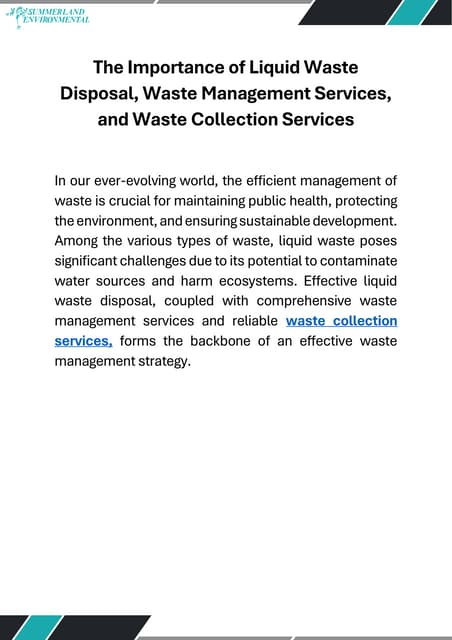Some Known Details About Reclaim Waste
Some Known Details About Reclaim Waste
Blog Article
Top Guidelines Of Reclaim Waste
Table of ContentsUnknown Facts About Reclaim WasteThe Best Guide To Reclaim WasteFascination About Reclaim Waste6 Simple Techniques For Reclaim WasteThe Best Guide To Reclaim WasteAll about Reclaim Waste

Never place dangerous materials down sinks, commodes or stormwater drains pipes Compounds consisting of gas, oil, oil, chemicals and herbicides, and solvents such as paint strippers need to not be poured down sinks, toilets or stormwater drains. These compounds are tough to eliminate in the sewer therapy procedure and create air pollution problems in our neighborhood rivers.

Although liquid waste is a term that covers a broad range of products, there's a good reason why leaving its disposal to the specialists is advised. Fluid waste is non-solid product that has no further usage and needs to be treated and disposed of according to neighborhood, state and government laws.
Reclaim Waste - Truths
Although examples of liquid waste can include wastewater, fats, oils or grease, made use of oil, liquids, solids, gases or sludges and unsafe family fluids, there are some that are thought about to be more unsafe than others when it pertains to the atmosphere and the health of animals and people alike. It's because of this that each state and area have rigorous guidelines linked to fluid waste management.
Liquid waste can be saved in holding tanks or packaged in drums, intermediate bulk containers or approved small containers before either being dealt with or gotten rid of through outsourced vacuum cleaner vehicles. Offered the nature of the products, fluid waste can not enter the basic waste stream and there are stringent policies on just how to dispose of it appropriately.
(https://www.intensedebate.com/people/reclaimwaste1)Relying on a decision of the level of threat, it may be necessary to remediate those websites. Additionally, hazardous liquid chemical wastes are regulated waste and needs to be tracked according to the state waste regulation. Under the chain of safekeeping and obligations, owners are responsible and liable for waste generated by an organization.
One of the core applications for superabsorbent polymers (SAPs) is fluid waste solidification. liquid waste removal. SAPs are made use of by waste management specialists to stop potentially hazardous fluids from getting in waterways, groundwater aquifers, and other sensitive settings. Due to the fact that fluids can Resources quickly transport pollutants right into environmental receptors and possibly add to geotechnical failures, liquid wastes are often banned from disposal in garbage dumps
The 5-Second Trick For Reclaim Waste
Basically, complimentary fluids are liquids that divide from the solid portion of waste product. Fluid waste can consist of the following: HDD mud and cuttings Landfill leachate Wastewater treatment sludge & biosolids Dug up debris Oil and gas drill cuttings Settling pond filth Hydro Excavation slurry Coal burning residuals/ash Storage tank base sludge Concrete grinding/polishing slurry Relevant Article: For a functional example of totally free liquids separating from waste product, think about the complying with circumstance: A waste management specialist loads a dump associate sludge from a wastewater treatment plant's aeration basin, throughout a routine maintenance event.
However, when the motorist gets to the landfill, he notices water leaching from the sludge and putting from the dump vehicle. The lots was rejected by the garbage dump and the chauffeur was forced to get rid of the waste as a fluid waste at a special center, which boosted the disposal charges greatly.
We likewise require to be responsible for the proper disposal of our waste materials. It is not enough that we pay waste disposal business to take care of our rubbish.
9 Easy Facts About Reclaim Waste Explained

Segregating your waste can start inside the home. Set apart completely dry and fluid waste as well as edible waste, naturally degradable and non-biodegradable materials.
Layer the bottom with dirt to absorb the damp waste. Layer the compost with damp and dry waste as well as soil to keep a balance between the wet and the completely dry.
What Does Reclaim Waste Mean?
To help with faster decomposition, you can likewise include semi composted dirt to the garden compost. If you discover the scent is becoming as well strong, add extra papers and paper waste or add more openings to the garden compost bin to maintain the balance of the waste materials.
The world is drowning in rubbish and we can't afford to be careless anymore. We have to do something about it and reuse whatever we can wherever we can. We also need to be accountable for the appropriate disposal of our waste materials. It is not nearly enough that we pay waste disposal business to look after our rubbish.
Our waste, our duty. Have you ever before questioned what occurs to your liquid waste after it's collected? Did you recognize that liquid waste can be recycled?
Rumored Buzz on Reclaim Waste
Segregating your waste can begin inside the home. Segregate dry and liquid waste as well as edible waste, biodegradable and non-biodegradable materials.
You can make use of old trash can, bucket, garden pot or old plastic drums. Drill 4 to five openings in the container so the air can circulate. Layer all-time low with soil to take in the wet waste. Begin the composting procedure. Layer the garden compost with damp and dry waste as well as soil to keep a balance in between the wet and the dry.
Cover the garden compost bin. When a week, add dirt on top of the compost. To help with faster decay, you can also include semi composted dirt to the garden compost. Preserve the garden compost. If you notice the odor is ending up being too solid, add added papers and paper waste or include more holes to the garden compost container to maintain the balance of the waste products.
Report this page